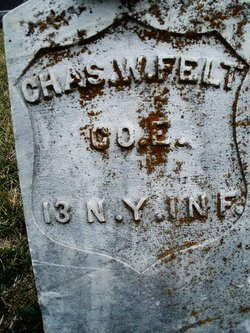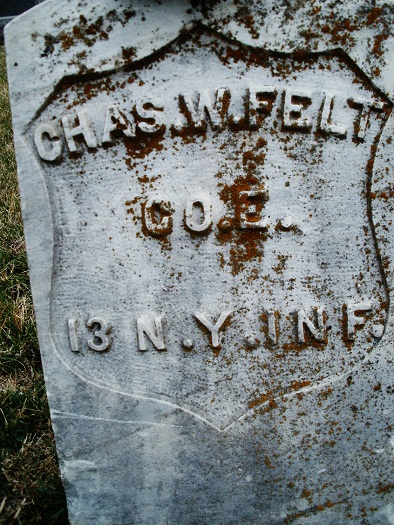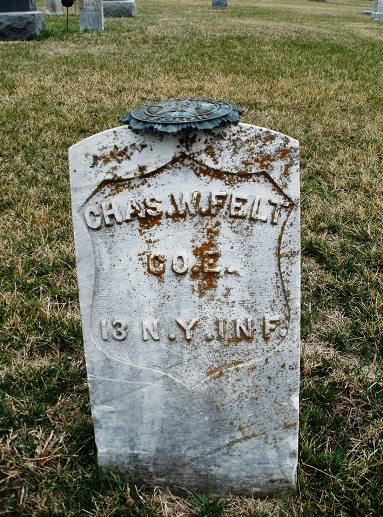Father: Norris Felt (1799-1881)
Mother: Emeline Spencer (1809-1853)
Spouse: Elizabeth Schofield (1846-1917)
Married 9 Aug 1874 in Hartford, WI
Children:
Grace Laura Felt (1875-?)
Nettie Harriet Felt (1876-1943)
Herbert Schofield Felt (1878-1942)
Garritt Sherley Felt (1885-1930)
(Thanks goes to John Peel #48280011 for all the information for this memorial!)
Charles Wesley Felt was born on 14 Aug 1842 in Salina, Onondaga, New York, USA to Norris and Emeline Spencer Felt. When he was 19, he enlisted as a Private in Company E, New York 13th Infantry Regiment on 14 May 1861, in Rochester, New York at the beginning of the Civil War. He served for 2 years in in the 13th and in Company C, 44th Infantry Regiment until 1863 when he was wounded in the chest. He was mustered out as an invalid and awarded a pension of $30 per month in Nov 1863. He learned carpentry and became a carpenter and a contractor.
Charles married Elizabeth Schofield on 09 Aug 1874, in Hartford, Wisconsin. He and Elizabeth had four children:
Grace Laura Felt, born 23 Jun 1875 in Chicago, Cook Co., IL
Nettie Harriet Felt, born 24 Dec 1876 in Hartford, Washington Co., WI
Herbert Schofield Felt, born 05 Sep 1878 in Hartford, Washington, Wisconsin, USA
Garritt Sherley Felt, born 12 Sep 1885 in Centralia, Nemaha Co., KS
The following is taken from The Union army: a history of military affairs in the loyal states, 1861-65 -- records of the regiments in the Union army -- cyclopedia of battles -- memoirs of commanders and soldiers. Madison, WI: Federal Pub. Co., 1908. volume II.
The 13th, the "Rochester regiment," composed of eight companies from Rochester, one from Dansville and one from Brockport, was mustered into the U. S. service at Elmira for a term of three months. It left Elmira on May 29, 1861, for Washington with the 12th, and camped on Meridian hill until June 3, when it was ordered to Fort Corcoran, where it was employed in construction work until the opening of the Manassas movement. It then became a part of the 3d brigade, 1st division, Army of Northeastern Virginia; was engaged at Blackburn's ford, and was active at Bull Run, losing 58 members. In August, under special orders, the regiment was mustered into the U. S. service for the remainder of the two years' term for which it had been accepted for state service. As in the case of the 12th the order was received with dissatisfaction, so openly expressed that some members of the 13th were sentenced to the Dry Tortugas for discipline, but afterward returned to the regiment. From Oct. 1 to March 10, 1862, the 13th performed guard and picket duty along the Potomac near Georgetown and was then assigned to Martindale's brigade, Porter's division, 3d corps, with which it participated in the Peninsular campaign. It had its share of the arduous duties in the siege of Yorktown, the tiresome marches on the Peninsula; and lost heavily in the Seven Days' battles. In May, 1862, it was assigned to the 1st brigade, 1st division, 5th corps, and after the Peninsular campaign and a brief rest at Harrison's Landing moved to join Gen. Pope. In the second battle of Bull Run the regiment was closely engaged and out of 240 in action, suffered a loss of 45 killed and many wounded and missing. Withdrawing to Washington, the regiment proceeded from there to the front; was held, in reserve at Antietam and went into camp at Sharpsburg, after a sharp encounter with the enemy at Shepherdstown. It reached the vicinity of Fredericksburg on Nov 19 and lost heavily in the battle there the following month. Returning to its former camp, the 13th participated in the "Mud March" and thereafter remained in winter quarters until the end of April, 1863. The 44th regiment, known as Ellsworth's Avengers, was organized at Albany under the auspices of the Ellsworth association of the State of New York. It was in reserve at Antietam; was active at Shepherdstown, and Fredericksburg; shared in the hardships of Burnside's "Mud March," and returned to winter quarters at Stoneman's switch, near Falmouth. Camp was broken on April 27, 1863, for the Chancellorsville campaign, the 44th being in the lead during the general movement of the army and sharing in the fighting, after which it returned for a short rest to the camp at Stoneman's switch. In June, the veterans of the 14th and 25th N. Y. were added to the 44th. At Gettysburg the regiment was posted on the left of the line and joined in the defense of Little Round Top, where it met with its greatest loss—111 killed, wounded and missing.
...
Father: Norris Felt (1799-1881)
Mother: Emeline Spencer (1809-1853)
Spouse: Elizabeth Schofield (1846-1917)
Married 9 Aug 1874 in Hartford, WI
Children:
Grace Laura Felt (1875-?)
Nettie Harriet Felt (1876-1943)
Herbert Schofield Felt (1878-1942)
Garritt Sherley Felt (1885-1930)
(Thanks goes to John Peel #48280011 for all the information for this memorial!)
Charles Wesley Felt was born on 14 Aug 1842 in Salina, Onondaga, New York, USA to Norris and Emeline Spencer Felt. When he was 19, he enlisted as a Private in Company E, New York 13th Infantry Regiment on 14 May 1861, in Rochester, New York at the beginning of the Civil War. He served for 2 years in in the 13th and in Company C, 44th Infantry Regiment until 1863 when he was wounded in the chest. He was mustered out as an invalid and awarded a pension of $30 per month in Nov 1863. He learned carpentry and became a carpenter and a contractor.
Charles married Elizabeth Schofield on 09 Aug 1874, in Hartford, Wisconsin. He and Elizabeth had four children:
Grace Laura Felt, born 23 Jun 1875 in Chicago, Cook Co., IL
Nettie Harriet Felt, born 24 Dec 1876 in Hartford, Washington Co., WI
Herbert Schofield Felt, born 05 Sep 1878 in Hartford, Washington, Wisconsin, USA
Garritt Sherley Felt, born 12 Sep 1885 in Centralia, Nemaha Co., KS
The following is taken from The Union army: a history of military affairs in the loyal states, 1861-65 -- records of the regiments in the Union army -- cyclopedia of battles -- memoirs of commanders and soldiers. Madison, WI: Federal Pub. Co., 1908. volume II.
The 13th, the "Rochester regiment," composed of eight companies from Rochester, one from Dansville and one from Brockport, was mustered into the U. S. service at Elmira for a term of three months. It left Elmira on May 29, 1861, for Washington with the 12th, and camped on Meridian hill until June 3, when it was ordered to Fort Corcoran, where it was employed in construction work until the opening of the Manassas movement. It then became a part of the 3d brigade, 1st division, Army of Northeastern Virginia; was engaged at Blackburn's ford, and was active at Bull Run, losing 58 members. In August, under special orders, the regiment was mustered into the U. S. service for the remainder of the two years' term for which it had been accepted for state service. As in the case of the 12th the order was received with dissatisfaction, so openly expressed that some members of the 13th were sentenced to the Dry Tortugas for discipline, but afterward returned to the regiment. From Oct. 1 to March 10, 1862, the 13th performed guard and picket duty along the Potomac near Georgetown and was then assigned to Martindale's brigade, Porter's division, 3d corps, with which it participated in the Peninsular campaign. It had its share of the arduous duties in the siege of Yorktown, the tiresome marches on the Peninsula; and lost heavily in the Seven Days' battles. In May, 1862, it was assigned to the 1st brigade, 1st division, 5th corps, and after the Peninsular campaign and a brief rest at Harrison's Landing moved to join Gen. Pope. In the second battle of Bull Run the regiment was closely engaged and out of 240 in action, suffered a loss of 45 killed and many wounded and missing. Withdrawing to Washington, the regiment proceeded from there to the front; was held, in reserve at Antietam and went into camp at Sharpsburg, after a sharp encounter with the enemy at Shepherdstown. It reached the vicinity of Fredericksburg on Nov 19 and lost heavily in the battle there the following month. Returning to its former camp, the 13th participated in the "Mud March" and thereafter remained in winter quarters until the end of April, 1863. The 44th regiment, known as Ellsworth's Avengers, was organized at Albany under the auspices of the Ellsworth association of the State of New York. It was in reserve at Antietam; was active at Shepherdstown, and Fredericksburg; shared in the hardships of Burnside's "Mud March," and returned to winter quarters at Stoneman's switch, near Falmouth. Camp was broken on April 27, 1863, for the Chancellorsville campaign, the 44th being in the lead during the general movement of the army and sharing in the fighting, after which it returned for a short rest to the camp at Stoneman's switch. In June, the veterans of the 14th and 25th N. Y. were added to the 44th. At Gettysburg the regiment was posted on the left of the line and joined in the defense of Little Round Top, where it met with its greatest loss—111 killed, wounded and missing.
...






